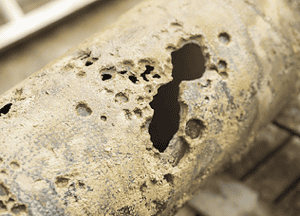By Brett Walton, Circle of Blue
Elliot Olsen has been litigating Legionnaires’ disease cases for a dozen years and he’s never been as busy as today.
“I’ve got more lawsuits going now than I ever have,” said Olsen, a lawyer with Siegel Brill, a firm based in Minneapolis. Olsen, who represents people nationwide sickened with the pneumonia-like illness, said that Legionnaires’ cases account for about one-third of his current work load.
There is plenty of work to go around. The number of people who fall ill with Legionnaires’ disease in the United States is soaring, up 33 percent in 2018 compared to the previous year, according to data released this week by the Centers for Disease Control and Prevention. The disease, which is not contagious, is caused by inhaling water droplets that are contaminated with Legionella bacteria. It frequently sends people to the hospital, and it kills about one in 11 people infected.
In tandem with the rising disease burden is a corresponding increase in the number of lawsuits, according to lawyers involved in these cases.
Most legal actions are civil lawsuits against building owners or their maintenance contractors for negligence or failure to protect guests on their property, a personal injury claim akin to a slip-and-fall case, lawyers say.
But criminal charges against Michigan health officials in the wake of 12 deaths in Flint linked to Legionnaires’ disease awakened the public health community to the legal risks of inaction against a disease that was first identified four decades ago but has grown in prominence only in the last few years. The involuntary manslaughter charges were dropped this summer by the Michigan Attorney General’s Office, but the shock has not worn off.
In light of the flurry of litigation, observers wonder whether legal liability will prompt changes in building management and oversight practices that are not yet mandated by law. Few jurisdictions in the country have any rules for preventing the spread of the bacteria that proliferate in building water systems.
New York, for instance, regulates cooling towers, a common source of bacteria transmission, and the federal government has ordered hospitals and nursing homes that receive Medicare payments to inspect and test their water systems. Beyond that, regulations are scarce for America’s deadliest waterborne disease.
“Generally speaking, this is one area where the potential for liability can drive self-regulation,” Lance Gable, an associate professor at Wayne State University Law School who studies public health law, told Circle of Blue. “Litigation sometimes gets out ahead of regulations imposed by government. The threat of litigation can drive behavior, and drive behavior in the absence of regulation.”
Civil Cases Dominate the Courts
Examples abound of legal actions that stem from alleged mismanagement of building water systems.
Last month, a man who contracted Legionnaires’ disease at the Mountain State Fair, in western North Carolina, sued the vendors whose hot tubs are suspected as the transmission source. The hot tubs were on display at an exhibition hall at the Western North Carolina Agricultural Center.
In September, the family of a woman who died from Legionnaires’ disease after staying at the Watkins Glen Harbor Hotel, in the Finger Lakes region of New York, sued the company that owns the hotel for alleged negligence in building maintenance.
And in August, a woman sued the Rush Oak Park Hospital, located in the Chicago suburbs, alleging the hospital was negligent and failed to warn patients about the bacteria.
For Olsen, these alleged failures are a familiar refrain. He sees the same mistakes repeatedly in his cases: building managers are ignoring their water systems.
“What I see most, in terms of a water management plan, is nothing — they have no water management plan in place,” said Olsen, who has been working on Legionnaires’ disease lawsuits for about 12 years. “So they have no strategy whatsoever to protect their building from being colonized by Legionella. That’s the most common thing I’ve seen.”
Olsen tries to prove that whoever is in charge of the building’s water supply, either the owner or a contractor, did not adequately maintain the system to prevent Legionella growth. The bacteria are present in lakes and rivers, but they multiply to the point where they become a health risk in warm, stagnant water — water that can be found inside building plumbing.
Health department officials investigate outbreaks, which are two or more cases linked to the same source. Those inquiries can be a boon to people filing a lawsuit if the health department investigation turns up solid evidence that connects the bacteria at the source to the bacteria that sickened individuals.
If there is no direct link to a bacteria source, having a water management plan in place that adheres to one of the industry standards is a good defense for a building owner in the event that someone gets sick, according to Russell Nassof, founder of the health risk consulting firm RiskNomics.
Environmental investigations for Legionnaires’ disease are complex and a “smoking gun” link between source of transmission and patient is hard to trace, Nassof said. Evidence that a building is checking its chlorine levels and water temperatures and periodically flushing its pipes is firm ground to stand on.
“If you have potential exposure points out there, different exposure points, and you have one, for example, with good documentation and a water management plan that has been maintaining their building pristinely, then in all likelihood you would start to look at other sources for potential liability,” Nassof told Circle of Blue.
Tom Bernier, a partner at Goldberg Segalla, is a defense lawyer in Legionnaires’ cases. Typical clients include building owners and maintenance contractors, but he has recently seen liability lawsuits extend to general contractors, architects, plumbing engineering people, and contractors that put in potable water systems.
When constructing a defense for his clients, Bernier seeks to call doubt on the direct link between building and plaintiff. Are there other potential sources of exposure? Is the bacteria of the same genetic type in both the building and the sick person? Could the person’s ailments be caused by something else?
Bernier sees the legal battleground aligning around the concept of the standard of care.
The most frequently cited standard of care today are guidelines put forward by ASHRAE, a group that develops standards for building systems. Those standards, called ASHRAE 188, were endorsed in 2017 by the Centers for Medicare and Medicaid Services, the federal agency that oversees payments to hospitals and nursing homes, and by the Centers for Disease Control and Prevention.
ASHRAE submitted its standards to a rigorous public comment period so that they could be adopted into building codes. Even so, the legal field is still evolving. Bernier said that most of his cases involve disease exposures that occurred before 2015, when ASHRAE 188 was adopted.
Before ASHRAE 188, courts tended to throw out Legionnaires’ claims because there was no industry standard on which to base a standard of care. It happened in an appellate court in New Jersey, in Vellucci v. Allstate Insurance Company, and it happened in a federal court in Virginia, in Flaherty v. Legum & Norman Realty.
“There are no industry standards that required Mack–Cali [the building manager] to have done anything more than what it did in response to the salient facts of this case,” Judge Jose Fuentes wrote in 2013 in the Vellucci opinion that upheld a trial court’s dismissal of the wrongful death claims.
Though many judges have decided what qualifies as a standard of care on an ad hoc basis, the field may now be changing, according to Bernier.
“With the growing number of guidelines and regulations, and a purported standard in ASHRAE Standard 188, plaintiffs’ attorneys may find it less difficult to establish what they argue as the standard of care in the prevention of Legionella amplification in a building that causes an exposure and illness,” Bernier recently wrote in Law 360.
“I tell our clients, to the extent that you have your t’s crossed and i’s dotted and you’ve got a water management program in place that meets ASHRAE 188, that’s a really good defense,” Nassof said.
Most civil cases today end in a settlement, resulting in few legal precedents. Olsen, for one, has not yet had a case go to trial. The terms of the settlements, most of which are in the low- to mid-six figures, are usually confidential, Olsen said. Dollar amounts can be set according to lost wages and compensation for suffering, but they are most directly tied to medical costs. “The higher the medical bills, the bigger the settlement,” Olsen said.
Flint Lawsuit Changes Perceptions
Rarer are criminal cases for Legionnaires’ disease, and rarer still are criminal cases filed against public officials.
Besides the charges in Michigan following the Flint water crisis, Gable of Wayne State University Law School could find no other example in the United States of a public official facing criminal charges for not responding quickly enough in a public health context, which is what the Attorney General’s Office had alleged.
The Attorney General’s Office withdrew the involuntary manslaughter charges in June, and would not comment on whether charges would be refiled.
Because public officials generally have immunity from liability in personal injury claims, state lawyers would have to meet a high bar, Gable said.
“The only way to overcome that with public officials is to show that the action was so egregious that it warrants exception to immunity,” Gable told Circle of Blue.
Even though Gable calls the case an outlier because these sorts of cases are rarely brought and difficult to prove, “it’s a pretty big outlier,” said Andy Baker-White, senior director of state health policy at the Association of State and Territorial Health Officials, the organization that represents public health agencies.
For state health agencies, the criminal charges reiterated the need for additional training in communication and crisis response, Baker-White told Circle of Blue. His organization is helping them develop those skills. But while the Flint bombshell raised awareness among public officials, Baker-White and his colleagues could not identify any jurisdiction that has changed its Legionella response policy as a result.
The Flint lawsuits “captured people’s attention,” David Dyjack, executive director of the National Environmental Health Association, told Circle of Blue.
Dyjack recalled a conversation with a state health official in the aftermath of Flint. The official revealed that what kept him awake at night was not opioids or obesity, but the “environmental stuff” — things like Legionella and lead that affect people where they live, work, and play.
Those epiphanies are beginning to surface more frequently. Dyjack said that the Flint lawsuits have prompted discussion among state health officials about legal liability. “That can of worms has been opened, and I think it is incumbent on us to be able to demonstrate that we are doing everything we can within our resources and know-how to protect every citizen from preventable exposures.”
Dyjack views prevention as part of his mission. He has been discussing legal liability for Legionella for over a year with state officials. His message to them is simple and direct: “Wake up.”
“We cannot walk on autopilot through our professional obligations,” Dyjack added. “We need to always be surveilling what is emerging, what science is emerging, what practice is emerging, and do our best to implement effective interventions within our resources. And if we did not, we need to cogently describe why we could not or did not use the best available technology or management system or approaches to reducing that risk.”
Outbreaks themselves usually catalyze action, Olsen said. Settlements he’s worked on haven’t stipulated changes required by the building owner. “They’re scrambling to make changes by the time I get involved,” he said.
“I think making a claim makes a difference for that particular building,” Olsen added. “They usually change their behavior has been my experience. The bigger question is how you get the industry as a whole to change.”


